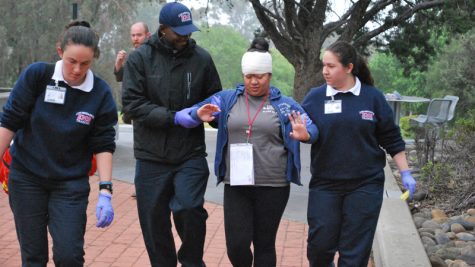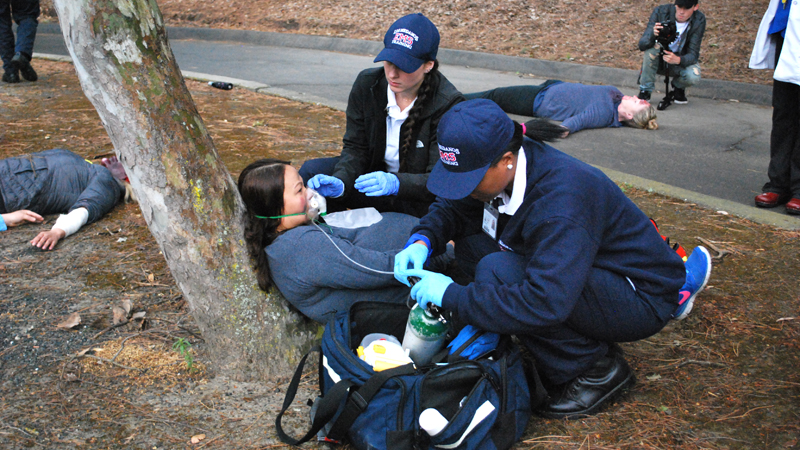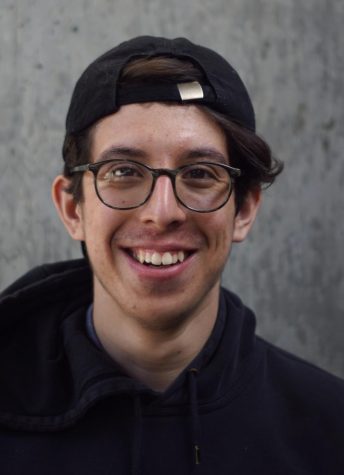LMC preps for emergencies
Students’ skills tested in active shooter simulation
April 14, 2017
If you walked past the LMC Lake or outside of the cafeteria Wednesday, you might have heard screaming. You might have also seen multiple students with burns, bruises and broken bones being aided by EMS students.
This scene was the result of an active shooter simulation put on by the Emergency Services, Fire Technology and police services.
Before the simulation could get underway, preparation was needed. Those who were playing the patients headed to the Moulage room, CC3-336 for makeup. It was there the students were given their faux lacerations and briefed on how they should conduct themselves.
“Sell the injuries you have,” instructed Officer Michael Hotton. He also encouraged the victims to intentionally “throw a curveball” at the EMS students to test whether or not they can assess the extent of their injuries even when given vague information.
While the victims were getting familiar with their roles, the EMS students were prepping for the event separately. They knew they were dealing with a mass casualty situation, but didn’t know what kind of attack they were handling.
The backstory of the simulation is that it’s an active shooter situation, in which both perpetrators were found dead on arrival. The objective was to help as many patients as possible by diagnosing them and leading them to safety.
The first part of the event started by the lake by the amphitheater. It was also raining as the EMS students rushed to help including a severe burn victim and a pregnant woman. About half an hour later, EMS students were herded to the upper level near the cafeteria assisting other patients. One included a blind woman looking for her Seeing Eye dog and a mother who lost her son.
EMS Student Sarah Hansen said she loved being able to help the patients. Onworking with firefighters and police aides, she said, “I think we worked well together especially because … we felt like a family.”
The event ended with a debriefing led by German Sierra. There, the triage officers overseeing the event discussed the things they noticed during the simulation.
EMS Student Christian Smith said while it was realistic, “it would be a lot more chaotic in real life, this was more of a controlled situation.”
Though there were minor issues with the way the EMS students handled some of the victims, they were assessed and told that overall, they did well.
EMS Student Josh Marchio said his class was prepared. “We’re all pretty well-trained,” he said.
He admitted they would have done better if they stayed organized and went to different areas rather than congregating in one spot at the beginning. “We would’ve done a lot better if we all kind of split up.” Despite this, he though the class did a good job overall.
Trang Nguyen said one of the differences between this year and last year is that the class is smaller but Marchio says he’s ok with this because bigger classes “seem more impersonal.” In smaller classes, you get to make better connections with your classmates and the instructors.
Smith summed up the event saying, “it was very nerve-wracking but it was so fun.”
If you walked past the LMC Lake or outside of the cafeteria Wednesday, you might have heard screaming. You might have also seen multiple students with burns, bruises and broken bones being aided by EMS students.
This scene was the result of an active shooter simulation put on by the Emergency Services, Fire Technology and police services.
Before the simulation could get underway, preparation was needed. Those who were playing the patients headed to the Moulage room, CC3-336 for makeup. It was there the students were given their faux lacerations and briefed on how they should conduct themselves.
“Sell the injuries you have,” instructed Officer Michael Hotton. He also encouraged the victims to intentionally “throw a curveball” at the EMS students to test whether or not they can assess the extent of their injuries even when given vague information.
While the victims were ge tting familiar with their roles, the EMS students were prepping for the event separately. They knew they were dealing with a mass casualty situation, but didn’t know what kind of attack they were handling.
tting familiar with their roles, the EMS students were prepping for the event separately. They knew they were dealing with a mass casualty situation, but didn’t know what kind of attack they were handling.
The backstory of the simulation is that it’s an active shooter situation, in which both perpetrators were found dead on arrival. The objective was to help as many patients as possible by diagnosing them and leading them to safety.
The first part of the event started by the lake by the amphitheater. It was also raining as the EMS students rushed to help including a severe burn victim and a pregnant woman. About half an hour later, EMS students were herded to the upper level near the cafeteria assisting other patients. One included a blind woman looking for her Seeing Eye dog and a mother who lost her son.
EMS Student Sarah Hansen said she loved being able to help the patients. On working with firefighters and police aides, she said, “I think we worked well together especially because … we felt like a family.”
The event ended with a debriefing led by German Sierra. There, the triage officers overseeing the event discussed the things they noticed during the simulation.
EMS Student Christian Smith said while it was realistic, “it would be a lot more chaotic in real life, this was more of a controlled situation.”
Though there were minor issues with the way the EMS students handled some of the victims, they were assessed and told that overall, they did well.
EMS Student Josh Marchio said his class was prepared. “We’re all pretty well-trained,” he said.
He admitted they would have done better if they stayed organized and went to different areas rather than congregating in one spot at the beginning. “We would’ve done a lot better if we all kind of split up.” Despite this, he though the class did a good job overall.
Trang Nguyen said one of the differences between this year and last year is that the class is smaller but Marchio says he’s ok with this because bigger classes “seem more impersonal.” In smaller classes, you get to make better connections with your classmates and the instructors.
Smith summed up the event saying, “it was very nerve-wracking but it was so fun.”


